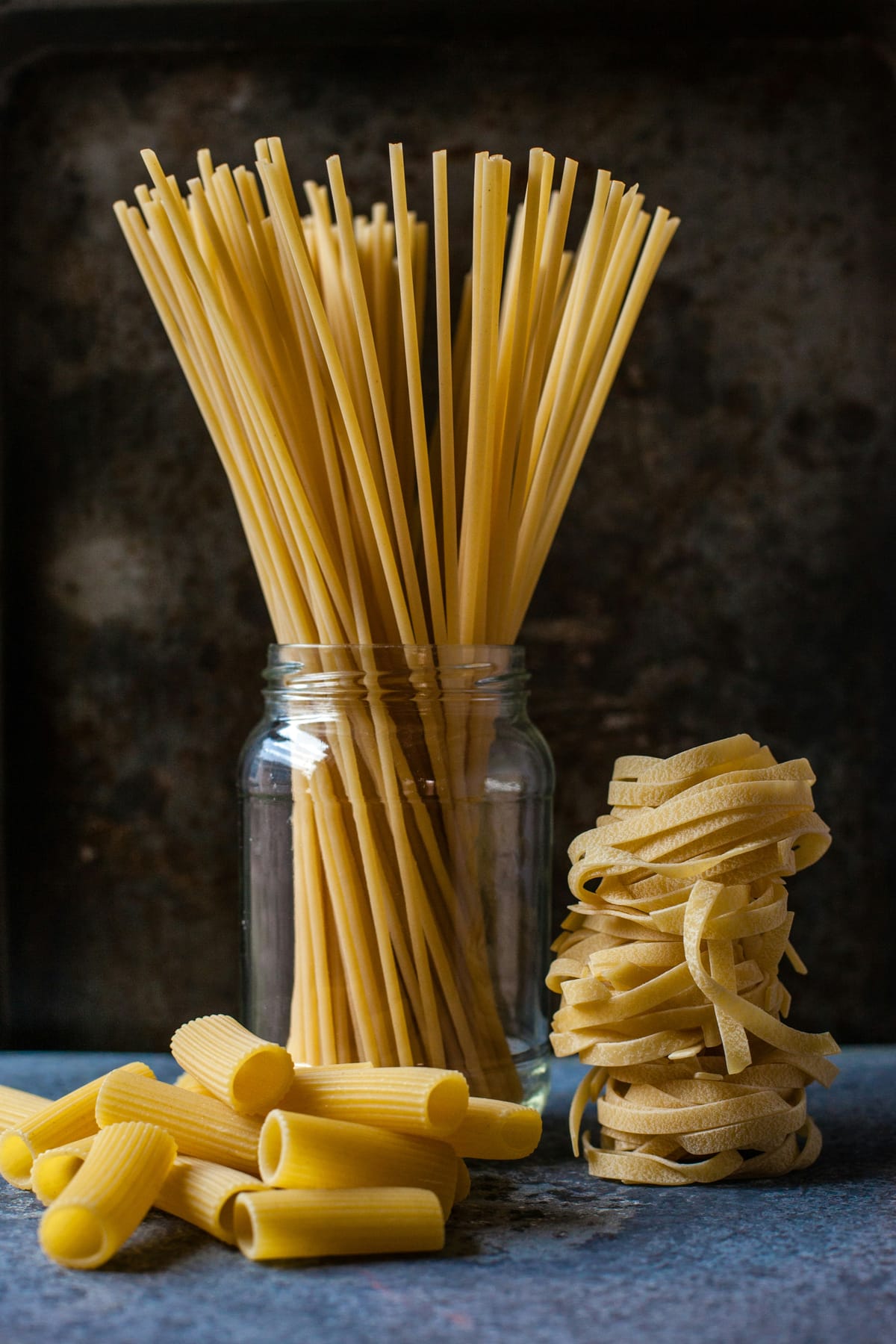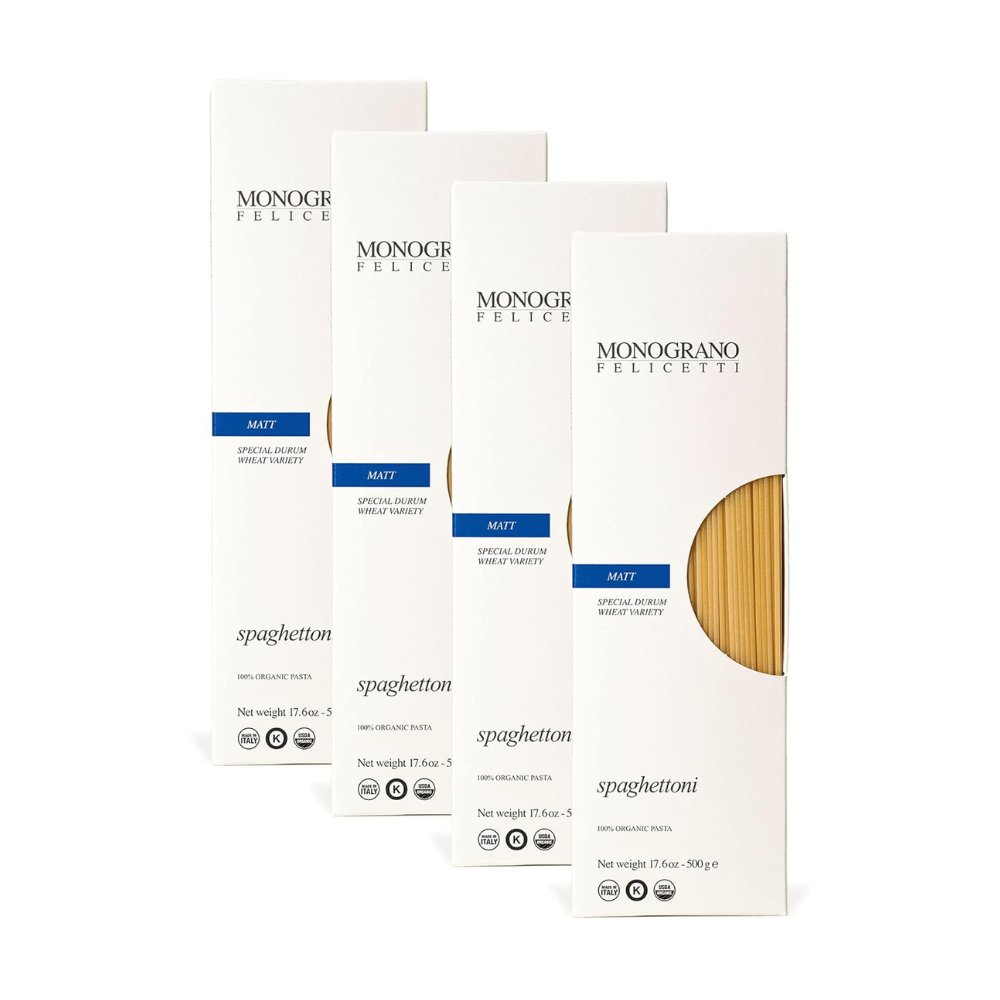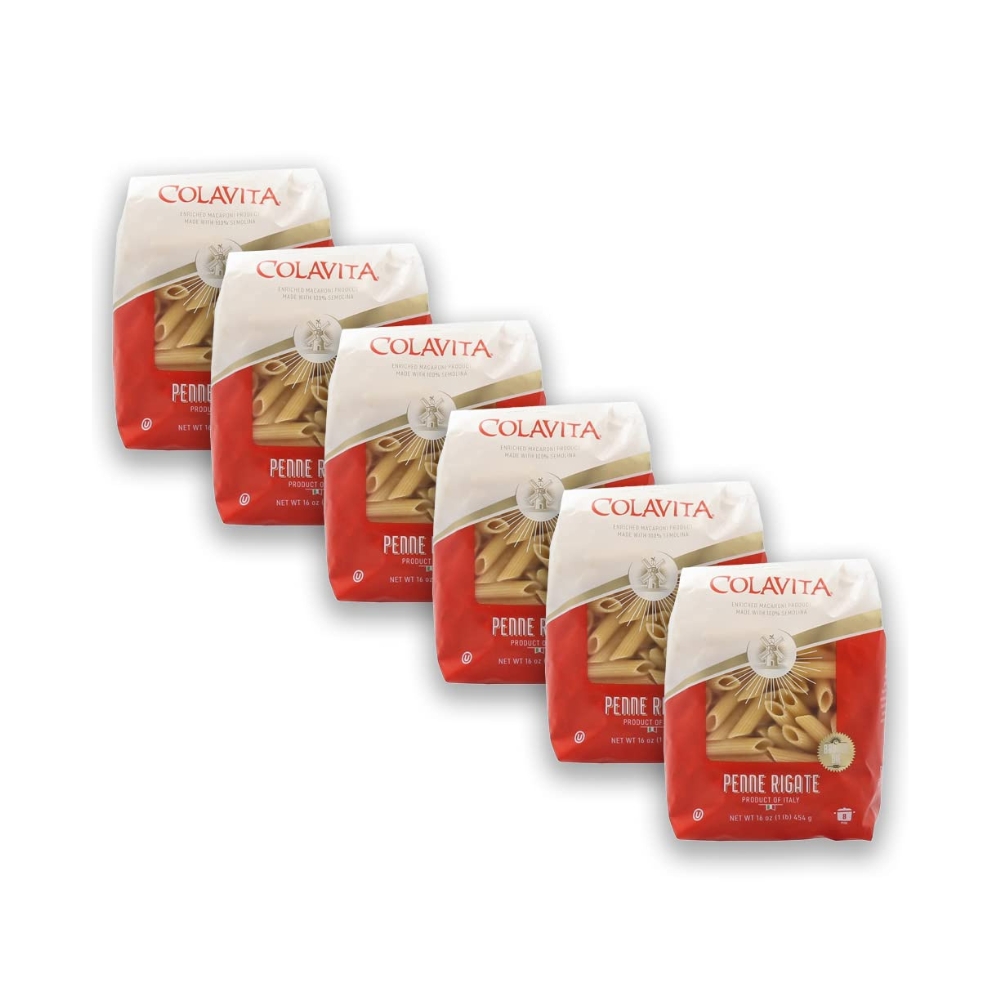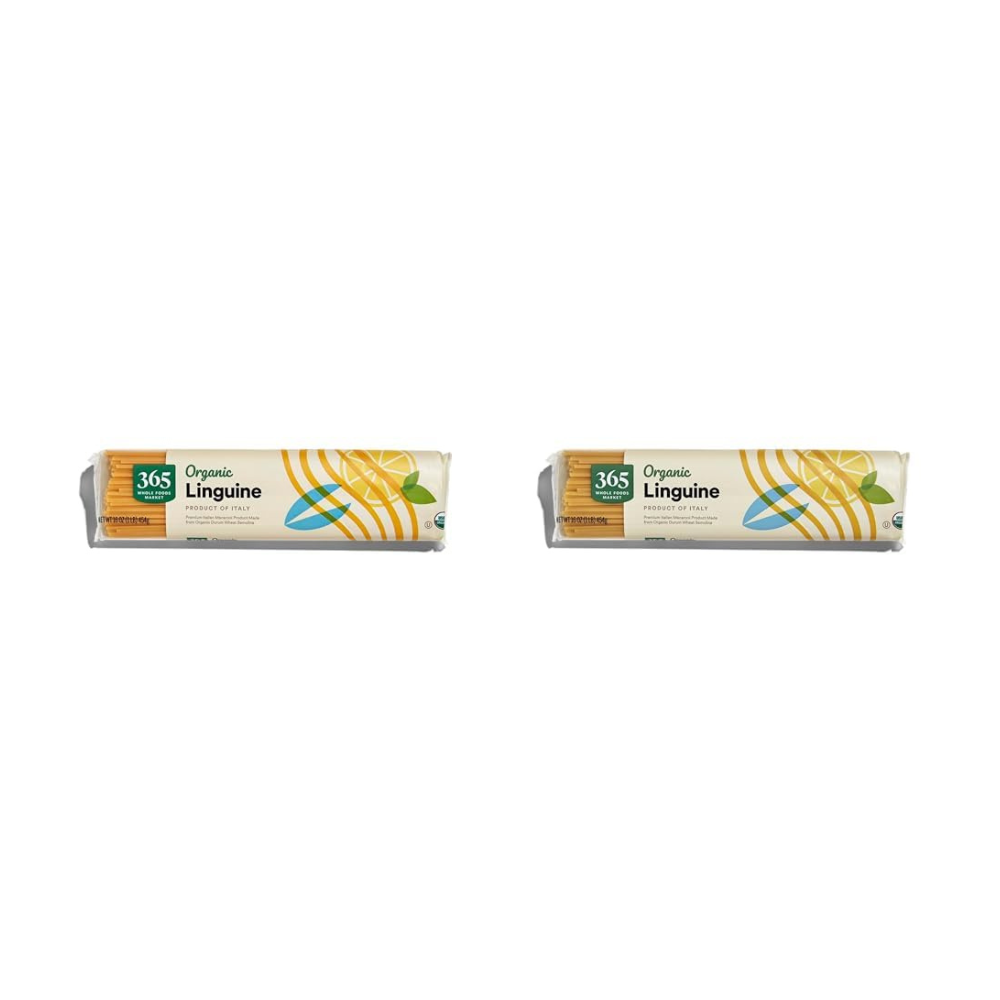The Pasta Quest: Unveiling The Best Pasta Brand

Are you tired of bland pasta options at the grocery store?
Look no further! We have embarked on a quest to find the best pasta brands out there. These brands will elevate your pasta game to new heights with their authentic flavors, innovative cuts, and dedication to quality.
Imagine twirling perfectly al dente pasta in your fork, covered in your favorite sauce, and bursting with flavor. With our recommended brands, you can experience this Italian trattoria-level perfection right at home.
Say goodbye to dull and uninspired meals - it's time for an exciting journey through all the possibilities that fresh pasta has to offer.
Ready to add some excitement back into mealtime? Join us on this ultimate pasta quest and discover the best brands that promise to take your taste buds on a flavorful ride. Don't wait any longer - grab these top-notch pastas now!
How We Choose The Best Foods
In a world bursting at the seams with countless food products, how can you discern the true gems from the duds? Imagine the disappointment and skepticism settling in as you realize that, yet again, you’ve fallen prey to clever marketing rather than genuine quality.
Enter Kiki – your trusted friend in the relentless quest for quality. Kiki revolutionizes the way we assess food quality by energetically testing products with a pendulum.
With Kiki, you gain access to a meticulously curated selection of food products, each tested and vetted for supreme quality beyond what traditional methods can offer.
Trust in Kiki to be your beacon of reliability in the tumultuous sea of food choices. With us, you’re always assured of unparalleled quality, because when Kiki has you covered, choosing the best for your needs and budget has never been easier.

Organic Italian Pasta From Monograno Felicetti

#1 Best Pasta Brand
Organic Italian Pasta From Monograno Felicetti
Energy Test Levels: 9.8/10
Why Do We Promote It
Nestled at the foot of the breathtaking Dolomite Mountains in Northern Italy, there's a little pasta company that's been doing things differently since 1908. Monograno Felicetti, founded by Valentino Felicetti, sparked a revolution in a place where pasta was hardly the star of the dinner table.
Around here, folks leaned towards risotto and polenta, but that didn't deter the Felicettis. Fast forward to today, and they're leading the pack as the largest producer of organic pasta globally.
What's their secret? Maybe it's the crisp mountain air or the pure waters flowing through the Val di Fiemme, but this family-run business believes in working hand in hand with nature.
They're all about respecting the ecosystem, promoting biodiversity, and, of course, crafting some of the best pasta you'll ever taste.
What's Good About It
Step into a world where tradition meets the pinnacle of pasta perfection with Organic Italian Pasta from Monograno Felicetti. Each strand tells a story of heritage and care, grown in the sun-kissed fields of Puglia, Italy.
This Matt variety of durum wheat, chosen for its remarkable flavor, fills the air with the scent of summertime hay and pleases the palate with notes of stone-baked bread and butter upon every bite.
Monograno Felicetti stands as a testament to the bond between a family of artisans and the dedicated farmers they've partnered with for generations.
The carefully selected Single Modern Heritage grain durum wheat is transformed into semolina flour and matched with unmatched pasta-making skills, pristine alpine water, and clean mountain air. It's a process that ensures every pack of pasta is a masterpiece of flavor and tradition.
Imagine a pasta that refuses to falter – perfect al dente texture every time, without sticking or boiling over. Through four generations of artisanal mastery, Felicetti has crafted just that.
The promise of perfect pasta every day is no small feat, but one that this esteemed brand delivers with unwavering consistency.
Curated by the discerning tastes of Michelin Starred Restaurants across Italy and beyond, Monograno Felicetti boasts an esteemed reputation. It’s not just pasta; it’s a culinary experience that elevates the humble wheat to new heights.
With each forkful, savor a product revered for its ability to hold onto the cherished "al dente" texture, bringing a touch of Italian luxury to dining tables around the world.

Authentic Italian Pasta From Colavita

#2 Best Pasta Brand
Authentic Italian Pasta From Colavita
Energy Test Levels: 9.3/10
Why Do We Promote It
Since 1979, Colavita has been sending its Italian treasures to every corner of the world, setting the bar pretty high for what truly great Italian tastes like. Picture this: nestled in the scenic lands of Molise and near the historic vibes of Pomezia in Rome, that's where the magic happens.
This is where the heart of Colavita beats, bustling and alive, crafting the essence of Italy in every bottle and package.
If you've ever wondered why their olive oil tastes so fresh, it's because their olives don’t have time to loiter; they're pressed soon after they're plucked from the trees, capturing their prime flavor.
And their pasta? Only the finest durum wheat gets the nod, mingling with pure mountain spring water to create something truly special.
At Colavita, they're all about the details. Every product, from oil to pasta, passes the strictest checks, ensuring only the best makes its way to you. It's not just food; it's their promise of Italian quality, delivered.

What's Good About It
Discover the taste of authentic Italy with Colavita's Penne Rigate Pasta. This 6 pack of pasta is a true staple for any home cook looking to bring a piece of Italian culinary tradition into their kitchen.
Made with 100% durum wheat and fresh mountain spring water, Colavita ensures that each bite is as wholesome as it is delicious. There are no salts or artificial ingredients added, making it a pure, natural choice for your pasta dishes.
Produced in Italy by the skilled hands of Italians, this pasta carries with it the tradition and quality that has been upheld since the company's founding in 1912. It's not just pasta; it's a piece of Italian heritage.
Whether you're whipping up a quick meal or adding it to your favorite recipe, Colavita's Penne Rigate Pasta is versatile and easy to cook. Its perfect texture and ability to hold sauces make every dish a delight.
Imagine the endless possibilities with Colavita's pasta as your foundation. From classic pasta dishes to innovative culinary creations, it's the ideal canvas for your cooking adventures.
Experience the authentic taste of Italy in every bite with Colavita. It's more than just pasta; it's an invitation to explore, enjoy, and revel in the rich flavors of Italian cuisine right from the comfort of your home.

Organic Linguine Pasta By 365 Whole Foods Market

#3 Best Pasta Brand
Organic Linguine Pasta By 365 Whole Foods Market
Energy Test Levels: 9.8/10
Why Do We Promote It
At 365 by Whole Foods Market, they're all about keeping things simple, but special. Imagine wandering through aisles stocked with all the goodies you love - from your morning granola to the cleaning spray that smells like a fresh spring day.
But here's the kicker: everything you pick up, from the tastiest snack to the most effective supplement, passes a super strict checklist.
We're talking about real ingredients that you can pronounce, and you won't find any of those sneaky additives lurking around.
They believe that living well shouldn't be complicated, so they've done the homework, making sure you bring home nothing but the best. It's like having a friend who's got your back, making sure you're treating yourself right, every single day of the year.
What's Good About It
Introducing Organic Linguine Pasta by 365 Whole Foods Market, your perfect partner for those rich, cozy dinners you love. Crafted straight from the heart of Italy, this premium pasta promises to bring a touch of authentic Italian culinary magic right into your kitchen.
Made from organic durum wheat semolina, it holds onto sauces like it was born to do so. Whether it's a classic rich clam sauce or a vibrant, nutty pesto, this linguine ensures every bite is packed with flavor.
The secret? It’s all in the generations of know-how and passion for pasta perfection. Made in a true pastificio, this pasta is not just food, it’s an experience waiting to unfold on your dinner table.
365 by Whole Foods Market doesn't just stop at offering you a high-quality product. They're all about trust and quality, making sure that each packet of Organic Linguine Pasta meets their rigorous standards, which say a strict no-no to over 100 ingredients.
What's more, it brings the joy of shopping back. With 365 by Whole Foods Market, you're not just tossing basics into your cart; you're choosing from a vast selection of premium pasta traits that make grocery shopping something to look forward to.
Lastly, this Organic Linguine Pasta isn’t just a meal choice; it’s a decision to invite joy, authenticity, and quality into your life, one delicious noodle at a time. Get ready to dance down the dinner aisles, real or virtual, with this delightful offering that's sure to elevate your great pasta nights.

Best Pasta Brand FAQs
Have you ever found yourself lost in the pasta aisle, overwhelmed by the plethora of choices and brands, each claiming to be the best?
Enter Kiki, the pasta brand designed to eliminate all confusion with clear, informative answers to all your burning questions about choosing the best pasta.
Kiki distinguishes itself by not just claiming to be the best but by proving it—through transparency about our sourcing, our authentic Italian manufacturing process, and our dedication to unparalleled taste and quality.
With Kiki, you can elevate your meals with the confidence that you've chosen a pasta brand that brings the genuine taste of Italy right to your table, every time. Say goodbye to aisle confusion and hello to culinary bliss with Kiki. Your palette and your dishes deserve nothing less.
Which Brand Is Best For Pasta?
When it comes to pasta, there are countless brands available in the market, each claiming to be the best.
First and foremost, let's talk about quality. Barilla has been producing pasta since 1877 and has cemented its reputation as one of the most reliable and high-quality brands in the industry.
They use only premium quality ingredients sourced from trusted suppliers to ensure that every bite of their pasta is nothing short of perfection.
But what truly sets Barilla apart from its competitors is its commitment to tradition and authenticity. Unlike other mass-produced brands that use industrial methods, Barilla still follows traditional methods of making pasta which involves using bronze dies for shaping the dough.
This not only gives their pasta a unique texture but also allows it to hold onto sauces better.
Not only that, but Barilla also offers an extensive range of pasta ranging from classic spaghetti and penne to more specialized shapes like farfalle and orecchiette. No matter what type of dish you're craving or cooking up, you can count on finding the perfect match with Barilla's diverse selection.
One major factor that influences our buying decisions these days is health consciousness. And when it comes to healthy eating choices, rest assured that Barilla has got you covered too.
They offer a whole wheat version for almost all their products which are rich in fiber and essential nutrients while maintaining the same great taste.
Additionally, if you have any dietary restrictions or preferences such as gluten-free or vegan options, look no further than Barilla's lineup specifically designed for those needs.
Aside from taste and quality, another aspect where this brand stands out is sustainability. With increasing concerns over the environmental impact caused by food production processes worldwide, it's comforting to know that companies like Barilla are actively taking steps towards sustainability.
They have implemented sustainable practices in their supply chain, reducing CO2 emissions and water usage while supporting local farmers.
But it's not just the products that make Barilla the best brand for pasta, it's their dedication to promoting a healthy and enjoyable lifestyle through food. Their website offers numerous recipes and cooking tips, making it easy for anyone to whip up a delicious pasta dish in no time.
In conclusion, whether you're a seasoned chef or just someone looking to enjoy a tasty meal at home, choosing Barilla as your go-to pasta brand is sure to leave you satisfied.
With its commitment to quality ingredients, tradition, diversity of options, health consciousness, and sustainability efforts - there's simply no better choice than Barilla regarding pasta excellence.
Which Is The Healthiest Pasta?
With an overwhelming variety of pasta options on the market, it can be difficult to determine which is the healthiest choice.
While some may argue that all pasta should be avoided to maintain a healthy diet, the reality is that pasta can be a nutritious and satisfying addition to any meal when chosen wisely.
Firstly, it's important to note that not all pastas are created equally. White or refined pasta contains little nutritional value as it has been stripped of its wheat germ and bran during processing, leaving behind only simple carbohydrates with no fiber or essential vitamins and minerals.
On the other hand, whole grain or whole wheat pasta retains these beneficial components and provides significantly more nutrients such as B vitamins, iron, magnesium, and zinc.
But what sets one type of whole-grain pasta apart from another? In terms of health benefits, there are three main factors to consider: fiber content, glycemic index (GI) score, and protein content.
Fiber plays an important role in maintaining a healthy digestive system and promoting feelings of fullness after a meal. Whole grain pastas typically have higher fiber content than their refined counterparts. For example, one cup of cooked white spaghetti contains only 2 grams of fiber compared to 6 grams of whole wheat spaghetti.
The glycemic index measures how quickly carbohydrates from food raise blood sugar levels. Foods with lower GI scores (55 or less) are considered better choices for maintaining steady blood sugar levels as they are digested slower than high GI foods (>70). Whole grain pastas generally have lower GI scores compared to white pastas due to their higher fiber content which slows down digestion.
Protein is another key factor when determining the nutritional value of different types of pasta. Protein helps build muscle mass and provides energy for daily activities.
Traditional wheat-based pasta has low protein levels while alternative options like chickpea or lentil-based pasta contain significantly higher amounts making them ideal choices for plant-based diets or those looking to increase protein intake.
So which pasta ranks highest among these criteria? The answer is whole-grain, high-fiber pasta made from alternative grains like quinoa, lentils, chickpeas, and brown rice.
These options not only meet the above-mentioned benchmarks but also are gluten-free and provide a wider range of essential nutrients compared to traditional wheat-based pasta.
In conclusion, the healthiest pasta is one that is made from whole grains with high fiber content and low GI scores. Alternative grain options such as quinoa, lentil or chickpea pastas provide additional benefits due to their higher protein content and gluten-free nature.
So next time you're craving a hearty bowl of pasta, make sure to choose wisely to reap all the nutritional benefits it has to offer!
How Can You Tell If Pasta Is High Quality?
Firstly, let's establish what makes good quality pasta. Top-notch pasta should have a firm and chewy texture, hold its shape when cooked, and have a distinct flavor profile that complements the accompanying sauce or dish.
One of the tell-tale signs of high-quality pasta is the type of flour used in its production. The best pasta is made with durum wheat semolina flour, which gives it a golden hue and robust resistance to overcooking. Quality brands will often proudly state this on their packaging.
Next, take a look at the ingredients list on the package. Ideally, it should only contain two items: flour (preferably semolina) and water. Avoid any additives or preservatives as they can impact both taste and texture.
Another crucial factor in determining quality is how the pasta was crafted. Traditional Italian methods involve slowly extruding dough through bronze dies which give the finished product rough edges that help sauces cling to them better.
This process also creates tiny air pockets in each strand of spaghetti or penne, resulting in lighter yet toothsome textures.
On your next grocery trip, pay close attention to how long your chosen brand takes to cook - high-quality pasta typically requires longer cooking times than cheaper alternatives since they aren't loaded with fillers like cornflour or rice starch.
Color also speaks volumes about a brand's commitment to quality; darker-colored pasta is not necessarily inferior but may indicate that lower-grade wheat has been used during production.
Lastly - don’t be afraid to splurge! Premium brands may cost more upfront but remember you get what you pay for when it comes to this beloved Italian staple; delicious noodles packed with nutrients such as protein-rich gluten (yes really!), B vitamins, iron, and fiber.
In conclusion, top-tier pasta is not just about the brand name or fancy packaging. It's all about understanding what makes for an exceptional product and knowing how to spot it. Keep these pointers in mind next time you're shopping for pasta and bid farewell to bland noodle dishes forever. Bon Appetit!
What Pasta Do Italians Use?
Pasta, one of the staples of Italian cuisine, has a rich and diverse history that dates back centuries. With so many different types of pasta available in markets around the world, it can be overwhelming to determine which ones are truly authentic and used by Italians.
The truth is, there is no single type of pasta that all Italians use. The type of pasta used in any given dish varies based on regional traditions, personal preferences, and even seasonal availability. However, some popular types are commonly found in Italian kitchens and restaurants.
One example is spaghetti - long strands of thin noodles made from durum wheat flour. This iconic pasta hails from Naples and is often served with tomato-based sauces or simple olive oil and garlic.
Another well-known type is penne - short tubes with diagonally cut ends that resemble quills. Originally from Campania in Southern Italy, penne pairs well with thicker sauces like ragu or creamy cheese-based sauces.
In Northern Italy, you will find more egg pasta such as tagliatelle and fettuccine. These flat ribbons of dough are perfect for soaking up hearty meat sauces or delicate cream-based sauces.
Further south in Sicily, bucatini reigns supreme - a thick spaghetti-like noodle with a hole running through the center similar to a straw. It's usually served with rich tomato sauce topped off with grated pecorino cheese.
If you're looking for something lighter yet still filling, ravioli may be your answer. These small square pockets filled with savory ingredients like cheese or spinach can be found throughout Italy but originated in the regions of Lombardy and Emilia Romagna.
Speaking of Emilia Romagna - this region also claims tortellini as their invention! These small ring-shaped stuffed pastas were traditionally served on special occasions like Christmas Eve.
And let's not forget about lasagna - perhaps one of the most popular Italian dishes outside of Italy. This savory layered pasta dish originated in the region of Emilia Romagna and can be found in various fillings such as meat, vegetables, or cheese.
But it's not just about the shape of the pasta, it's also about the quality of ingredients used to make it. Italians take great pride in using high-quality durum wheat flour and fresh eggs to create their pasta dough. This results in a deliciously chewy texture that perfectly holds onto any sauce or filling.
In addition to these traditional types of pasta, there are also countless variations and regional specialties that vary widely from town to town in Italy.
Some may use seafood-based sauces while others focus on hearty meat dishes. The possibilities are endless when it comes to creating mouthwatering Italian meals with different types of pasta.
So next time someone asks you what type of pasta Italians use, remember that there is no one answer - but rather a rich variety that reflects the diverse culture and history of this beloved cuisine. Buon appetite!
What Is The Hardest Pasta To Cook?
When it comes to good pasta, there are few things more frustrating than undercooked or overcooked noodles. While many types of pasta are relatively easy to cook evenly, there is one that stands out as the most difficult: gnocchi.
Gnocchi is a type of Italian pasta that is made from a combination of potatoes, flour, and eggs. This may sound simple enough, but achieving the perfect texture and consistency can be quite challenging.
One of the main reasons why gnocchi is so difficult to cook is because it requires a delicate balance between moisture and starch. If there isn't enough moisture in the dough, the gnocchi will be too dry and dense; but if there is too much moisture, they will fall apart when cooked.
Furthermore, unlike other types of pasta which can be cooked directly in boiling water for a set amount of cooking time, gnocchi must be carefully monitored as they cook. They are done when they float to the surface of boiling water - this usually takes only 2-3 minutes.
But even after achieving this crucial step in cooking gnocchi, there's still room for error. If left in the boiling water for too long after floating to the top, they can become mushy and lose their shape entirely.
In addition to precise timing and monitoring during the cooking process, making good-quality gnocchi also requires skillful shaping techniques. The dough needs to be rolled out into long ropes before being cut into small pieces and rolled against a ridged surface with your thumb or fork tines.
This creates ridges on one side while leaving an indentation from your finger on another side - these contribute towards creating little pockets where sauce clings.
But don't let these challenges discourage you from trying your hand at making homemade gnocchi! With practice and patience, anyone can master this delectable pasta dish that has been enjoyed by Italians for centuries.
Moreover, the effort and care put into making homemade gnocchi will result in a far more flavorful and authentic dish than any store-bought options. Plus, impressing your friends and family with a plate of perfectly cooked gnocchi will surely make you the star of any dinner party.
In conclusion, while there are plenty of easy pasta dishes to cook, gnocchi takes the crown for being the most challenging. But with the right techniques and careful attention, anyone can achieve that perfect balance between soft yet firm pillows of potato goodness.
So don't be afraid to take on this culinary challenge - just remember to have patience and enjoy the delicious results. Buon appetite!
Is It Worth Buying Expensive Pasta?
First and foremost, let's talk about taste. Cheap pasta tends to have a bland and artificial flavor, often leaving you feeling unsatisfied after a meal.
On the other hand, premium pasta made from high-quality ingredients will burst with rich and authentic flavors that will transport you straight to Italy with every bite. The texture of expensive pasta is also noticeably superior - firm yet tender, providing the perfect balance for your taste buds.
But it's not just about taste when it comes to pricey pasta - it's also about quality ingredients. High-end brands often use top-grade durum wheat or semolina flour as opposed to regular all-purpose flour used in cheaper alternatives.
This results in a higher protein content which gives the pasta its distinctive al dente texture and prevents it from becoming mushy when cooked.
Furthermore, premium pasta is often crafted using traditional methods such as bronze-drawing or slow-drying techniques which give them an unparalleled authenticity and depth of flavor.
These techniques require time and meticulous attention to detail but they ultimately result in a product that is truly superior in quality.
Now some may argue that buying expensive pasta isn't necessary because all pastas essentially taste the same once covered in sauces or mixed with other ingredients.
However, this couldn't be further from the truth! High-quality noodles have their unique character which enhances any sauce or dish they are paired with rather than getting lost among other flavors.
Additionally, purchasing expensive pasta supports small businesses that prioritize sustainability and ethical practices over profit margins.
By choosing artisanal products made by passionate individuals who care deeply about their craft rather than mass-produced items from big corporations focused solely on making a profit, you are also investing in a better world.
In conclusion, buying expensive pasta is worth it for those who truly appreciate the art of pasta-making. Not only will you be rewarded with an exceptional gastronomic experience, but you will also be supporting small businesses and sustainable practices.
So next time you're at the grocery store, don't hesitate to spend a few extra dollars on that high-end pasta - your taste buds (and conscience) will thank you!
Is Pasta Unhealthy Or Healthy?
Pasta is a staple food in many cultures, and it has been a topic of debate whether it is healthy or unhealthy.
Some say that pasta is high in carbohydrates and can lead to weight gain, while others argue that it is a good source of energy and nutrients. So let us uncover the truth behind this popular Italian dish.
Firstly, let's talk about the nutritional value of pasta. One cup (200 grams) of cooked pasta contains around 200 calories, 7 grams of protein, and only one gram of fat.
This means that pasta provides a good amount of energy without adding unnecessary fat to your diet. It also contains essential minerals such as iron, magnesium, and zinc which are crucial for maintaining overall health.
Moreover, contrary to popular belief, carbohydrates are not necessarily bad for our health. They are the main source of fuel for our body and provide us with the much-needed energy to carry out daily activities. The key here is moderation – eating too much or too little carbs can have negative effects on our health.
Now coming to the concern about weight gain from consuming pasta - yes, if you eat large portions or top your pasta with heavy sauces like alfredo or cream-based sauces then you may be at risk for weight gain.
However, when consumed in moderate portions along with lean protein sources such as chicken or fish and vegetables like broccoli or spinach; pasta can aid in weight loss due to its low-calorie content.
Furthermore, pasta also has a low glycemic index which means it does not spike your blood sugar levels quickly compared to other carbohydrate-rich foods like white bread or sugary snacks. This makes it an ideal choice for people with diabetes who need to manage their blood sugar levels effectively.
But wait! There's more! Pasta also contains gluten which has been getting some bad rep lately but hear me out before you decide against having another spaghetti carbonara ever again. Gluten is a protein found in wheat and other grains and it helps foods maintain their shape.
Contrary to popular belief, gluten sensitivity or intolerance is quite rare, affecting only about 1% of the global population. Some studies suggest following a gluten-free diet may lead to nutrient deficiencies.
In conclusion, pasta can be both healthy and unhealthy depending on how it is prepared and consumed. Opting for whole grain or whole wheat pasta over white pasta will provide more fiber which can aid in digestion and weight management.
Additionally, adding lean proteins and vegetables to your pasta dish will boost its nutritional value even further.
What Color Pasta Is Best?
The color of pasta can be influenced by various factors such as ingredients used, cooking methods, and even geographical location. However, the most significant factor that determines the color of pasta is the type of flour used to make it.
Traditional Italian pasta is made from semolina flour, which is a coarse flour derived from durum wheat. This type of flour gives the pasta its signature yellow hue and adds a subtle nutty flavor to it. It also has a higher gluten content than other flours, making it perfect for holding its shape when cooked.
On the other hand, some colorful pasta is made using different types of flour mixed with natural ingredients like spinach for green pasta or beetroot for red/pinkish tinted ones.
While these colorful variations add an interesting visual element to dishes, they often lack depth in taste compared to traditional semolina-based pasta.
Now comes the moment we've all been waiting for – drumroll please – insert drum roll sound effect. The best color pasta is….drumroll getting louder… golden brown!
Toasting not only enhances its nutty flavor but also gives it a delightful crunch while still maintaining its al dente texture. It elevates your regular bowl of boring beige-colored spaghetti into a mesmerizing symphony of flavors and textures that will have your taste buds dancing with joy!
In addition to being tastier than regular semolina-based pasta, whole wheat pasta is packed with nutrients and fiber that promote gut health and keep you fuller longer. Plus points for both your taste buds and overall well-being!
But wait, there's more! Whole wheat and spelled pasta also have a lower glycemic index compared to traditional pasta, meaning they won't cause a spike in your blood sugar levels. This makes them an ideal choice for people with diabetes or those looking to maintain a healthy weight.
So next time you're craving pasta, skip the colorful gimmicks and opt for the earthy goodness of whole wheat or spelled pasta. And if you want to take it up a notch, try making your own homemade whole wheat pasta – it's easier than you think and oh-so-rewarding.
In conclusion, while color may add visual appeal to dishes when it comes to taste and nutritional value, golden brown rules supreme in the world of pasta. So go ahead and elevate your plate with this underrated but superior-colored pasta option. Happy cooking!
How Long Should Pasta Be Dried?
Pasta is one of the most versatile and beloved foods in the world. Its rich history dates back to ancient times, with evidence of pasta being consumed by civilizations such as the Etruscans and Romans. From spaghetti to penne, linguine to lasagna, countless varieties of pasta can be prepared in endless ways.
One important step in preparing pasta is drying it before cooking. Drying pasta helps remove excess moisture from the noodles, making them easier to cook and enhancing their flavor. But how long should you dry your pasta for optimal results?
The answer varies depending on a few key factors: the type of pasta, humidity levels, and personal preference.
Firstly, let's talk about different types of pasta. Shorter pasta like macaroni or penne has a higher surface area compared to longer ones like spaghetti or fettuccine. This means that shorter pasta will dry faster than longer ones due to their increased exposure to air.
In addition, humid environments impact drying time as well. If you live in a humid climate, your pasta may take longer to dry compared to someone living in a drier climate.
Now onto personal preference - this ultimately comes down to how "al dente" you prefer your pasta. Al dente means "to the tooth" in Italian and refers to perfectly cooked but still slightly firm noodles. For those who enjoy al dente pasta (which many Italian chefs would argue is the only way), less drying time is needed as it will continue cooking when boiled.
So considering all these factors, here are some general guidelines for drying different types of dried paste:
- Short pasta (such as penne or macaroni): 2-3 hours
- Long pastas (spaghetti or fettuccine): 4-6 hours
But remember - these are just approximations! The best way to check if your pasta is properly dried is to simply taste it. Take a small bite and if there's still some hardness or crunchiness, then it needs more time to dry. If it's completely soft and pliable, then you've over-dried your pasta.
It's also important to note that the drying process can be sped up by using a dehydrator or oven set on low heat. Just keep an eye on the noodles as they can quickly go from perfectly dried to burnt.
In conclusion, how long you should dry your pasta ultimately comes down to personal preference and environmental factors. Whether you prefer a softer noodle or firmly al dente, following these guidelines will surely result in deliciously cooked pasta every time.
So go ahead and experiment with different drying times for different types of pasta - who knows, you may even discover your new favorite way of cooking it! Buon appetite!
Why Is Slow Dried Pasta Better?
There are a few key reasons why slow-dried pasta is superior to other types of pasta. Slow drying involves allowing the pasta to dry naturally, over several days, rather than using high heat or artificial methods to speed up the process.
First and foremost, slow drying allows for a more even distribution of moisture throughout the pasta. This results in a perfectly cooked texture - not too hard or chewy, but also not too soft or mushy. The slower drying process also helps maintain the shape and structure of the pasta, preventing it from clumping together or breaking apart.
Furthermore, slow-dried pasta retains more nutrients and flavor compared to its faster-dried counterparts. This is because high heat can cause some of the beneficial properties and flavors in the wheat to be lost during processing.
With slow drying, these essential elements remain intact, resulting in a pasta that not only tastes better but also provides more nutritional value.
In addition to taste and nutrition benefits, slow-dried pasta is also better for your health. Pasta made with traditional methods tends to go through multiple rounds of heating which can result in harmful compounds being released into the final product.
With slow drying techniques, there are no additional heating processes involved which means you're consuming fewer unhealthy substances.
Another major advantage of opting for slow-dried pasta is that it has a longer shelf life compared to fast-dried varieties. The natural method used in producing this type of pasta eliminates any potential bacteria growth since there's no added moisture involved during production.
What's more impressive about this type of pasta is that it holds sauces much better due to its rough texture when compared with other types made through rapid-drying techniques like spray- or freeze-drying methods; making it perfect for all kinds of dishes!
Overall, choosing slow-dried pasta over other options guarantees you’re getting quality noodles with fuller flavor profiles as well as improved cooking properties.

Best Pasta Brand For You
In conclusion, Kiki's extensive research and testing have led us to the discovery of the top pasta brands on the market. Our team has tirelessly worked to ensure that we provide you with only the highest quality and most delicious options available.
From taste testing to ingredient analysis, we have left no stone unturned in our quest for the perfect pasta. But don't just take our word for it - try these recommended brands yourself and see which one is your favorite!
Whether you're a fan of traditional Italian cuisine or are looking for a gluten-free option, our list has something for everyone. So if you want to know which pasta brand truly reigns supreme, don't hesitate to give them a try and let us know your thoughts.
Your support helps us continue researching and finding the best products to share with our readers, so thank you for joining us on this culinary journey. Bon appétit!
Pastafully,
Kiki And His Team






